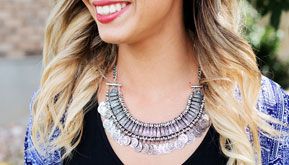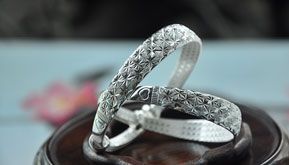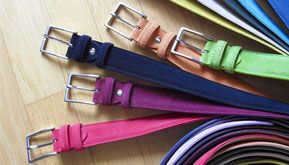Brief History Of Accessories
Jun 20, 2019 • 51 views
Accessories complete the perfect look. Sometimes, even when the whole outfit is flawless, a statement accessory can transform it to make it more glamorous. Necklaces, earrings, bracelets, belts, neckties, and headwear add finishing touches to many outfits. Some of the types of these accessories are classic and timeless like the pearl earrings and leather belts, but some were trendy and could be out of fashion after a while. As fashion changes throughout the years and decades, accessories evolve as well.
Since the beginning of civilization, people have been wearing accessories. The history of fashion accessories is a lengthy and broad subject, so we will break it down per accessory type.

Necklaces
Necklaces are adopted by early civilizations around the world. These are believed to be as old as 40,000 years. The oldest forms of the necklace are made from shells, teeth or bone beads, bird feathers, carved wood, seeds, stones and other artful natural elements found in the environment. Some used more precious materials from hard-to-find places, like the valuable necklace made of Mediterranean red coral beads found in a Neolithic remains in the Alps, dated around 4,200-3,400 BC.
When metalworking was developed, it added more jewelry options for humans. A flat, crescent-shaped neckpiece made of metal, or the lunula, is found in Bronze Age Scotland and Ireland in 1,800-1,500 BC. Meanwhile, the torc, a large, rigid neckpiece made of twisted metal, was found in the Celtic, Scythian and other cultures of the European Iron Age during 800 BC to 300 AD. These neckpieces were made of gold, copper, and other metals.
The ancient Egyptians’ necklaces were more complicated. From simple stringed bead necklaces, it evolved into a broad collar and pectoral types both women and men wore, especially the royalty and the wealthy.
Jewelry with gemstones was first used by the Romans during the first century. Later on, it became a trend for women to wear many necklaces at once until it’s use waned. In the late 14thcentury, necklaces regained popularity.
During the Middle Ages, necklaces replaced brooches as the primary form of jewelry. Gold chain necklaces with pendants and necklace sets with gemstone were in style. Their neck accessory usually indicates their social status and level of wealth.
Materials such as gold, silver, pearls, and diamonds have long been a popular choice for necklaces since the Western history of dressing until today. These often symbolize wealth, glamour, and prestige. Nowadays, the ideal necklace for professional, business and bridal dress are made up of these materials.
Locket necklaces were widely used in the 18thand 19thcenturies after photography was developed. It was mostly given as a betrothal gift.

Bracelets
After the ornaments for the neck, another oldest form of jewelry is the bracelet for wrist, arm or ankle. Archaeologists were able to date back the earliest bracelet to 7,500 BC found in Turkey. It was made of obsidian. Primitive humans were thought to have formed ancient bangles from stones, wood, and shells, then later on, from copper and bronze. The ancient Chinese wore bracelets on wrist made from wood, jade, and gold.
During Biblical times, bracelets were worn by both men and women, according to Hebrew Scripture. Some of the oldest-known bracelets were made of gold and bronze. The gold bracelets were often unadorned, while the bronze bracelets were decorated with designs.
Bracelets in Ancient Egyptian times were mostly strings of gold beads and hoops, and some were hinged. In Ancient Greeks, Romans and Assyrians, bracelets were often in the form of coiled spiral snakes or penannular armbands with enameled sphinxes and heads of lions or bulls. During the Iron Age, the spiral forms of bracelets with animal motifs were common in Europe. Meanwhile, the bracelets with separate, hinged panels were first created by the Etruscans, but the style was still popular in the early 21stcentury.
These arm trinkets were not only used as an adornment. In Celtic period Britain, men wore serpent-shaped bracelets and protective armlets to protect themselves from sword attacks. The Ancient Greeks soldiers wore metal cuffs on their upper and lower arms. When the Roman army saw this, they mimicked it and made their own arm accessories.
During the Middle Ages, the bracelet became unfashionable, but it was brought back again during the 17thcentury. Women began wearing bangles and wrist accessories made from ribbon strings. During the Victorian era, charms and pendant-style lockets became a trend in bracelets.

Earrings
The Sumerian women wore crescent-shaped gold hoop earrings at around 2,500 BC, according to archaeologists. In 1,500 BC Egypt, earrings were worn by both men and women. Ancient Egyptian earrings were usually mushroom-shaped studs or plugs to be stretched in the earlobe by an enlarged hole.
In the first millennium BC, Greeks and Etruscans wore earrings as a symbol of wealth. The wore hoop earrings, disk earrings, as well as leech earrings – a thick tube secured by a hidden wire, and box-type earrings. All these were stamped out of thin sheets of gold and were embellished with scrolls, flowers and fine palmettes
Later on, the Romans began to use gems or colored stones in earrings. This was imitated by other civilizations until the Roman influence began to decline. In the year 330 A.D., the Byzantine’s crescent-shaped, gold filigree earrings, and plain gold hoops with pearl pendants hanging on chains set the trend for ear accessory.
The practice of ear piercing for earrings re-emerged during the 1950s. The trend began as a fad among college girls, and Queen Elizabeth II set an example when she had ear piercing to be able to wear the diamond earrings she received as a wedding gift. By the 1970s, ear piercing became common among women. It was also when earrings returned to fashion for men, thanks to popular male music performers who set an example. Most of the men who wore earrings before were homosexuals, sailors or members of groups or gangs, but today, it has increasingly become more common and acceptable as something no other than decoration.
Multiple piercings in one or both ears also emerged into mainstream popularity in the 1970s. It became a trend to wear a second, third or more set of earrings within the ear. Asymmetric double piercing and cartilage piercing have become a trendy and acceptable practice.
Over time, different types and styles of earrings emerged. Earrings have become a form of personal expression and plainly a matter of personal choice – not indicative of social status, sexuality, moral or religious standards, and others.

Belts
Since the Bronze Age, belts were worn by ancient people. In ancient Rome, Greece, and Crete, people used it in the form of sash or girdle. Belts were common for both genders in the Western world, but it was more common for men.
In the latter part of the 19thcentury until World War I, the belt was used as a decorative and utilitarian part of the military uniform.
During the 20thcentury, men started wearing leather belts with the purpose of preventing the pants from falling. Women’s belts, on the other hand, were often made of the same fabric as their matching dress or coat. Belts of plastic or metal links have also been worn as a trendy fashion accessory.
Hats
The earliest known hat was worn by a Bronze Age man named Otzi, a mummified body frozen in a mountain where it was found to be there since around 3,300 BC. This headwear was a bearskin cap that looks like a Russian fur hat without flaps.
Ancient, upper-class Egyptians cover their heads with headdress to keep them cool. In Mesopotamia, people wore conical hats or those that resemble an inverted vase.
During the Middle Ages, hats denoted social status. In the late 16thcentury, women had structured hats like those of male courtiers.
A wide range of hats were designed during the 19thcentury. Women often wore bonnets, but eventually, it became larger, decorated with flowers, ribbon, feathers, and gauze trimmings. By the years pass by, more exotic and outrageous designs were made with women’s headwear.
